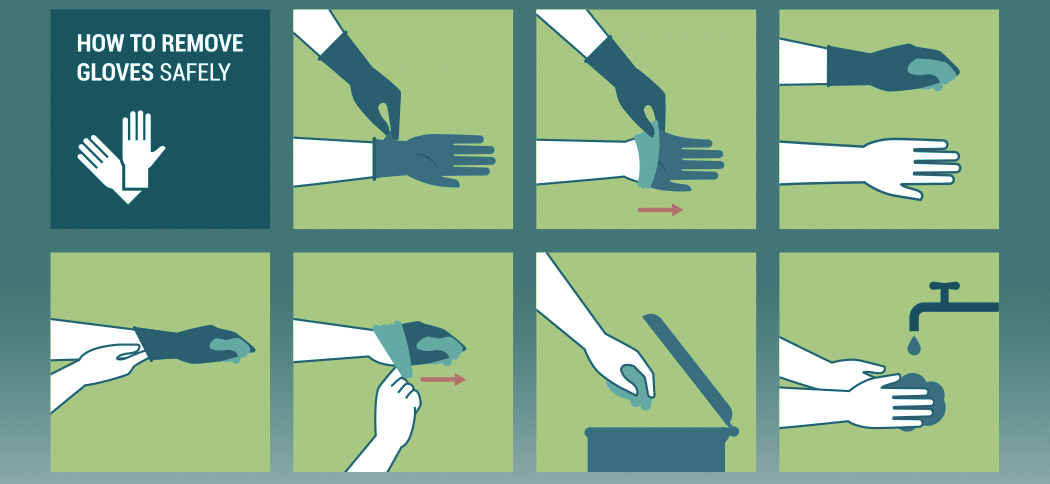Key-Points
Why There is a Proper Way To Remove Gloves
The Inside Out Method
The Glove-in-Glove Method
The Fold & Tuck Method

Did you know there are specific ways to properly remove gloves? Gloves are at the front line of preventing the spread of disease and hazardous materials through casual contact, mostly because our hands are one of the most critical tools we have when handling any kind of material. Therefore, they are a critical part of your PPE. It's important, especially when you might be exposed, to know the proper way to remove gloves.
Being exposed doesn't just refer to chemical substances such as certain acids, bases, or other reactives. Gloves prevent the spread of diseases such as viruses, which can be transmitted through body fluid or other biohazardous waste. If you're cleaning an area, it is important to protect yourself with gloves, and even more important to be mindful of your personal space to prevent spreading contamination.
As we've seen with the recent public crisis, gloves can become contaminated with high transmissible viruses, even potentially fatal enveloped viruses like HIV/AIDs. That's why being aware of removing gloves properly is important, especially in today's world.
Best Methods to Remove Disposable Gloves
So what is the best method of removing gloves if you have been handling items that pose a risk for spreading contamination? We've listed a few of the best below. Here are a few best methods that can be used:
The Inside Out Method

You may use this image with a link to Bio Recovery.
Without realizing, you may have intuitively used the inside out method in the past to remove your gloves.
- Pinch part of the cuff of the glove with the fingers of your other hand and pull the glove inside out, peeling it back away from your skin until it slides off the fingers.
- Since the inside of the glove is facing out and it is as clean as your skin was on the inside, you can use that surface as a barrier to pinch the cuff of your other glove and peel it away from your hand--cuff to fingertips--then discard of both gloves in an appropriate manner.
- Be sure to wash your hands afterwards to remove residue or stray contaminants.
The Glove-in-Glove Method

You may use this image with a link to Bio Recovery.
- Similar to the inside out method, you begin with pinching the cuff of one glove with the fingertips of the other to pull it away from your wrist.
- Then peel the glove down the hand, turning it inside out as it reaches the ends of your fingertips.
- Hold onto the discarded glove with your gloved hand.
- Next, use your index finger of your bare hand to slide between the cuff of your glove and your wrist and begin to peel the glove away from your hand.
- Again, peeling the glove back until it reaches your fingertips.
- The first glove you removed will be safely balled up on the inside of this glove, and both are readily disposed of without multiple contamination sources.
- Discard the glove ball and wash your hands thoroughly.
The glove-in-glove method is often recognized as industry standard--and might be one of the safest.
The Fold & Tuck Method

You may use this image with a link to Bio Recovery.
- Fold the fingers of one of your hands (not over your palms--don't make a fist).
- Pinch the gloved palm of the opposite hand with your gloved hand.
- Using your gloved hand, you may have to roll up the opposite gloved hand (as seen in step #3).
- Peel the glove of the opposite hand off
- Roll it into a ball with your solo gloved hand.
- Carefully place a finger under the cuff of the other glove
- Slowly peel your hand away over a garbage.
Keep it Clean
The most important part is to limit your contact with the contaminated surface of your gloves before going on to do anything else. This includes scratching your nose, shaking hands with someone, writing something down with a pen, opening a door, or even eating a sandwich. You might be surprised to see how people conduct themselves and seem totally ignorant of how they go about their day while wearing gloves. If you are cleaning up a hazardous site, or even scrubbing out a toilet, you need to be aware of your surroundings and the potential for cross-infection while wearing gloves.
Not Always a DIY Job
This article was intended to help those who are using PPE for small incidents and every day exposure. If you're dealing with a true biohazard situation, it's best to have the professionals come in and take care of it. We are trained to assess situations, use the appropriate PPE, and remediate the matter properly. Don't attempt to do it yourself. Give us a call immediately if you are in this situation.
Share this Post
